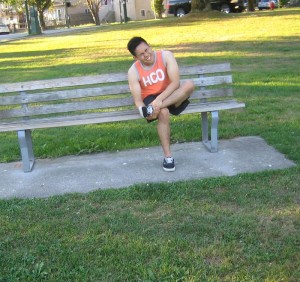Ankle fractures occur one or more of the bones in the ankle joint are broken. Ankle fractures ranges from a simple break in one of the bones to several fractures which results to misalignment. In severe cases, and there is a need to avoid placing weight on the affected area for a few months.
What are the indications?
- Bruising of the affected area
- Pain in the area which spreads from the foot to the knee
- Swelling of the leg or at the ankle
- Blisters can develop on the affected area

Pain in the area which spreads from the foot to the knee - Incapable of walking especially when the affected area becomes severe.
- Bones protruding through the skin
- Presence of blood in the joint
If the nerves or blood vessels are damaged, it will cause severe pain, paleness of the foot, numbness and incapacity to move the foot or toes. In such cases, it is vital to seek medical care immediately.
Causes
- Twisting of the ankle from side to side
- Rolling of the ankle in or out
- Applying a severe force to the joint such as jumping from a high level
- Flexing the extending the joint
Treatment for ankle fractures
- Get plenty of rest especially the affected ankle to prevent making the condition worse.
- Elevate the affected ankle above the level of the heart to lessen the pain and swelling.
- Apply a cold compress on the affected area on the first 12-24 hours to lessen the pain and swelling. Avoid applying the ice pack directly on the skin to prevent frostbite. Wrap with a towel or small piece of cloth before applying on the area.
- Take the prescribed pain medications such as ibuprofen to lessen the pain and inflammation.
- If the bones are not aligned properly, wear a splint for the ankle or placed in a non-weight bearing cast that requires the use crutches to allow the individual to walk.
Disclaimer / More Information
The material posted on this page on ankle fractures is for learning purposes only. Learn to recognize and manage broken bones and fractures including ankle fractures by taking a first aid and CPR class with one of our training providers.
Tips
- Avoid “slip and fall” accidents to prevent the risk for ankle fractures
- Fractures of any kind increases the risk of developing arthritis in the affected joint
- Use proper hiking shoes on rough roads, steel toed boots in work environments and proper athletic shoes when playing sports.
- Avoid wearing worn out shoes
- When running, alternate it with swimming or biking to prevent stress fractures.
- Eat calcium-rich foods such as yogurt, cheese and milk along with vitamin D supplements.
- If prone to twisting the ankle, seek the help of a physical therapist for exercises to strengthen the muscles that supports the ankle.
FACT CHECK
https://orthoinfo.aaos.org/en/diseases–conditions/ankle-fractures-broken-ankle/
https://www.webmd.com/fitness-exercise/ankle-fracture#1
http://www.aofas.org/footcaremd/conditions/ailments-of-the-ankle/Pages/Ankle-Fracture.aspx
